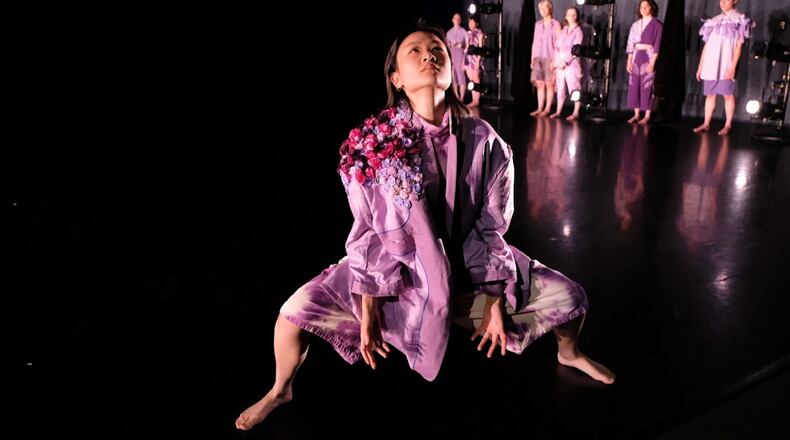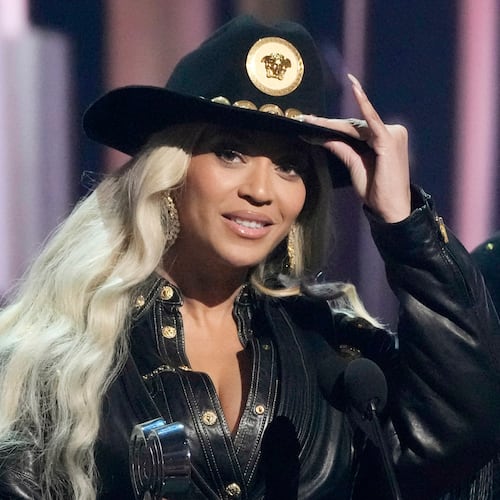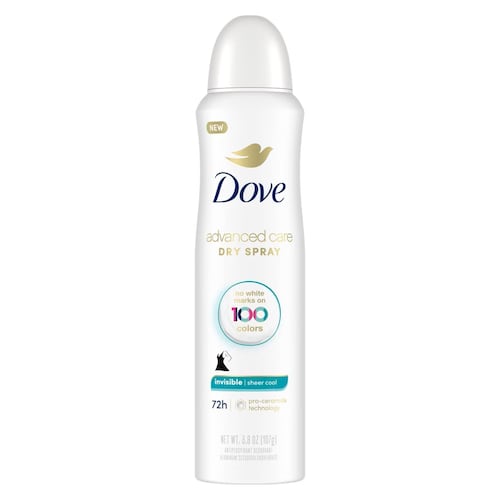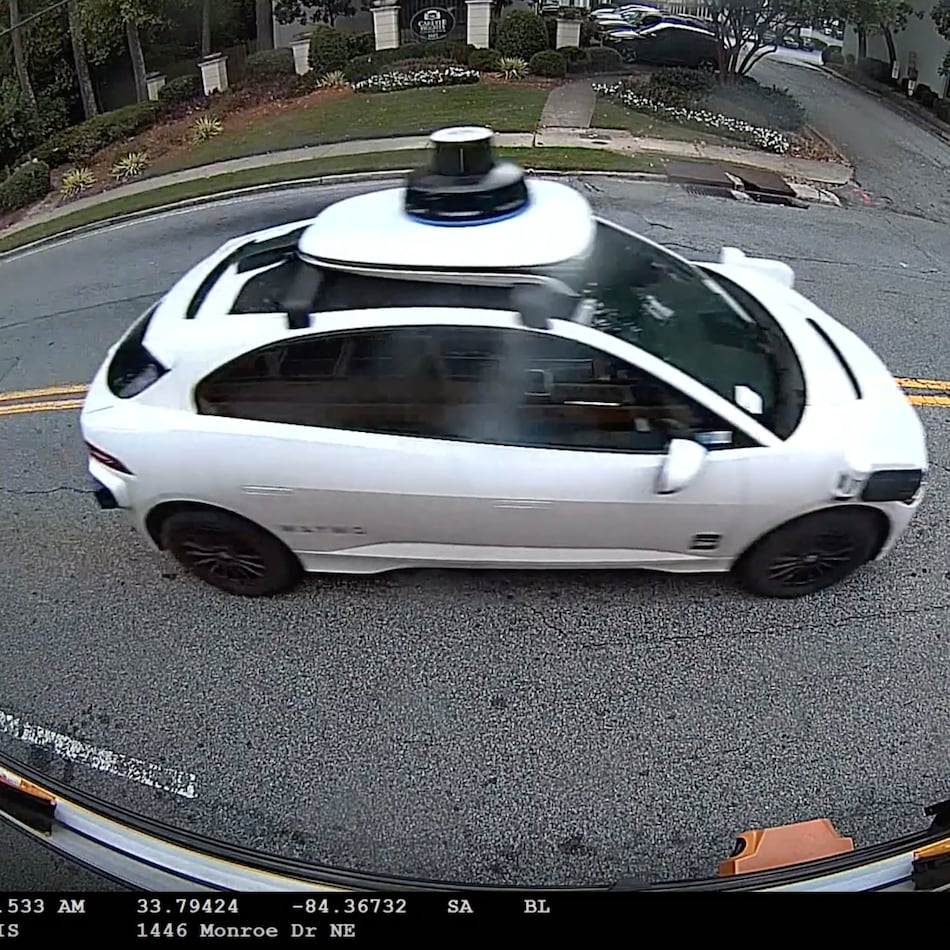This story was originally published by ArtsATL.
PhaeMonae, a self-described “movement engineer,” visual artist and clothing and costume designer is done with minimalism. Their unbounded physical practice privileges what they call the authenticity and joy of movement that feels good in the body, of becoming the best mover one can possibly be through play and exploration. “You don’t have to wear the same kind of underwear every day, you know,” PhaeMonae explained. “Every morning, you get to decide whether to wear the ones with the lace or the polka dots. Art should be like that, too, where you get to choose what brings you joy in that moment.”
In their work as a designer, they use upcycled materials and unexpected textile and pattern combinations to create the kind of “wearable art” that attracts double takes from curious children and prompts passersby to look up from their screens and smile.
Indeed, during an interview, PhaeMonae, dressed in a well-composed but casual outfit of subtly deconstructed elements, turned heads through the window of an East Atlanta eatery.
Credit: Photo by Brittany “Smiley” Gary
Credit: Photo by Brittany “Smiley” Gary
Their white polo — cropped and gathered just above the waist, with a starched, elegantly popped collar — and their long, asymmetrical polymer clay earrings in a psychedelic spectrum of vibrant hues drew several thumbs-up gestures and appreciative nods as PhaeMonae expounded on “Amplified Body,” their new project for Atlanta Beltline Art, debuting Sept. 28.
When PhaeMonae and their three collaborators — Magdalena O’Connor, LaMia Dingle and Cailan Orn — were developing their concept and proposal last year, the 50th anniversary of hip-hop’s origin was on everyone’s mind. Dingle specializes in hip-hop choreography and history, so that movement vocabulary, along with street fashion and hip-hop-inspired visual art, felt like a good fit.
Orn gained extensive puppeteering experience as a performer with New Orleans-based Lightwire Theater. O’Connor makes visual art using steel fabrication and welding techniques, but, like PhaeMonae, she also has a background in wearable art, including the creation of elaborately detailed “costumes” with body paint. PhaeMonae wanted to deploy that collective expertise to add what they described as a “creature” element to the show.
PhaeMonae said that as the group tossed out ideas, “Cailan was like, ‘Y’all thinking about noise or what the thing looks like?’” That turned their attention to nature’s noisemakers, and an image search turned up photos of the cicada. PhaeMonae told the group how much she loves cicadas. “Yes,” she told them, “let’s do the cicada!”
PhaeMonae and Dingle then went down the internet rabbit hole and found a YouTube video, created by a fan of both entomology and hip-hop, that describes hip-hop’s evolution and the cicada’s life cycle in four phases: emergence, search for community, expression of joy through the process of creation and existing as a collective sonic entity for survival.
The twist, however, is that only male cicadas make the characteristic buzzing din that fills hot summer days in a predictable cycle. “Amplified Body” tells the story of hip-hop’s “underdogs” — the female artists, the often avant-garde experimentalists and spiritual lyricists who narrate and create from fringes outside the pop culture mainstream.
PhaeMonae said that in their process, this sort of additive layering and matching the tools to the job are taking precedence over building and refining a singular movement vocabulary or a consistent and immediately recognizable look. “If there’s a form I want to learn, I just give it a try,” they said. “If I’m not good at it, well, let’s practice not being good at it.”
Credit: Photo by Madison Nunes
Credit: Photo by Madison Nunes
PhaeMonae grew up and began dancing in the Washington, D.C., and Baltimore area and moved to Atlanta in 2015.
They quickly attracted critical notice as a performer with T. Lang Dance and glo, earning recognition from ArtsATL in 2017 as “one to watch.” Kathleen Wessel described their performance in Lang’s “Post” that year as “unforgettable,” noting an “incredible moment … when PhaeMonae crouched in front of a line of women and stared at Scott Wheet for at least four minutes — a Black woman confronting a white man. With unwavering commitment, she softly shifted, cocking her head as if scanning through every memory and thought he’d ever had.”
While maximalism has turned out to be PhaeMonae’s signature, the freedom to transgress aesthetic and technical boundaries and their comfort with the risk of failure when attempting something new hasn’t come easily.
“When I was younger, coming up in the arts, especially as a Black person,” PhaeMonae recalled, “I felt I had to be a physical virtuoso, a big jumper, a big turner. And then, I also had to be as expressive and dedicated as possible. I felt pressure to conform to this ‘triple threat’ idea of being a dancer. Turns out, I hated that.”
Chasing the high that stemmed from meeting someone else’s standard of “excellence,” PhaeMonae discovered, often led to disappointment when the curtain came down and the stage lights went out. “I do think there is something very special in being minimal, in chipping away at the extra to see what is really valuable and essential” in a gesture or a line or a garment, they said. “But minimalism became the box I was told I had to work in as an artist in order to be taken seriously.”
PhaeMonae laughingly described a period in their 20s, when they first began emerging as a choreographer. They decided they would dance nude rather than accept the minimalism of critical and audience expectations — and lean budgets for contemporary dance performance — thrust upon them.
“It was very uncomfortable for my family, who didn’t necessarily want to see me up on stage naked,” PhaeMonae said. “I was beginning to recognize, though, how the flesh is clothing, with so many nuances. No two people are the same. So when you look at my flesh, you understand part of my essence as a person, versus when I’m wearing a black crop top and black high-waisted jeans and black Doc Martens, just like the other 10 people standing next to me.”
Credit: Photo by John Ramspott
Credit: Photo by John Ramspott
For PhaeMonae, clothing isn’t just something to be worn. It’s a part of the body itself. Their costume design draws inspiration from the African diaspora and ancestral ideas about adorning the body for sacred, military and medicinal purposes. They are also attuned to how an outfit and accessories such as jewelry or the right pair of shoes can signal status and offer “protective armor” in social situations.
In rejecting minimalism, PhaeMonae said they are pushing back against traditional notions of what constitutes fine art, a category that, they observed, “doesn’t make a lot of space for Black art or for what I’ve been calling — and I include myself in this category — trash artists.” Through thrifting and upcycling, PhaeMonae simultaneously draws attention to and attempts to ameliorate the environmental impact of the fashion and costume design industries.
PhaeMonae said they are also trying to find their way as an independent art maker without “feeding the beast” of perfectionism, figuring out how to work without driving themself and others to exhaustion. As a National Endowment for the Arts-funded DanceATL Engaging Atlanta Fellow, for example, PhaeMonae is reaching out to artist-mothers in communities of color to determine what resources would improve their personal and professional well-being.
Perhaps, most significantly, they are setting their own standards for judging their own artistic success. “I don’t have to be a couturier because that’s what some people think of as high fashion,” PhaeMonae said. “I don’t have to make up and stick to a form because that’s how some judge a choreographer’s success. I want to take trash and make it the most beautiful thing that you’ve ever seen.”
IF YOU GO
“Amplified Body”
Debuting 6:30-8:30 p.m. Sept. 28 at Westside Park (Entrance 1), 1621 Johnson Road NW, Atlanta. beltline.org
::
Robin Wharton studied dance at the School of American Ballet and the Pacific Northwest Ballet School. As an undergraduate at Tulane University in New Orleans, she was a member of the Newcomb Dance Company. In addition to a Bachelor of Arts in English from Tulane, Robin holds a law degree and a Ph.D. in English, both from the University of Georgia.
Credit: ArtsATL
Credit: ArtsATL
MEET OUR PARTNER
ArtsATL (artsatl.org) is a nonprofit organization that plays a critical role in educating and informing audiences about metro Atlanta’s arts and culture. ArtsATL, founded in 2009, helps build a sustainable arts community contributing to the economic and cultural health of the city.
If you have any questions about this partnership or others, please contact Senior Manager of Partnerships Nicole Williams at nicole.williams@ajc.com.
About the Author
Keep Reading
The Latest
Featured






